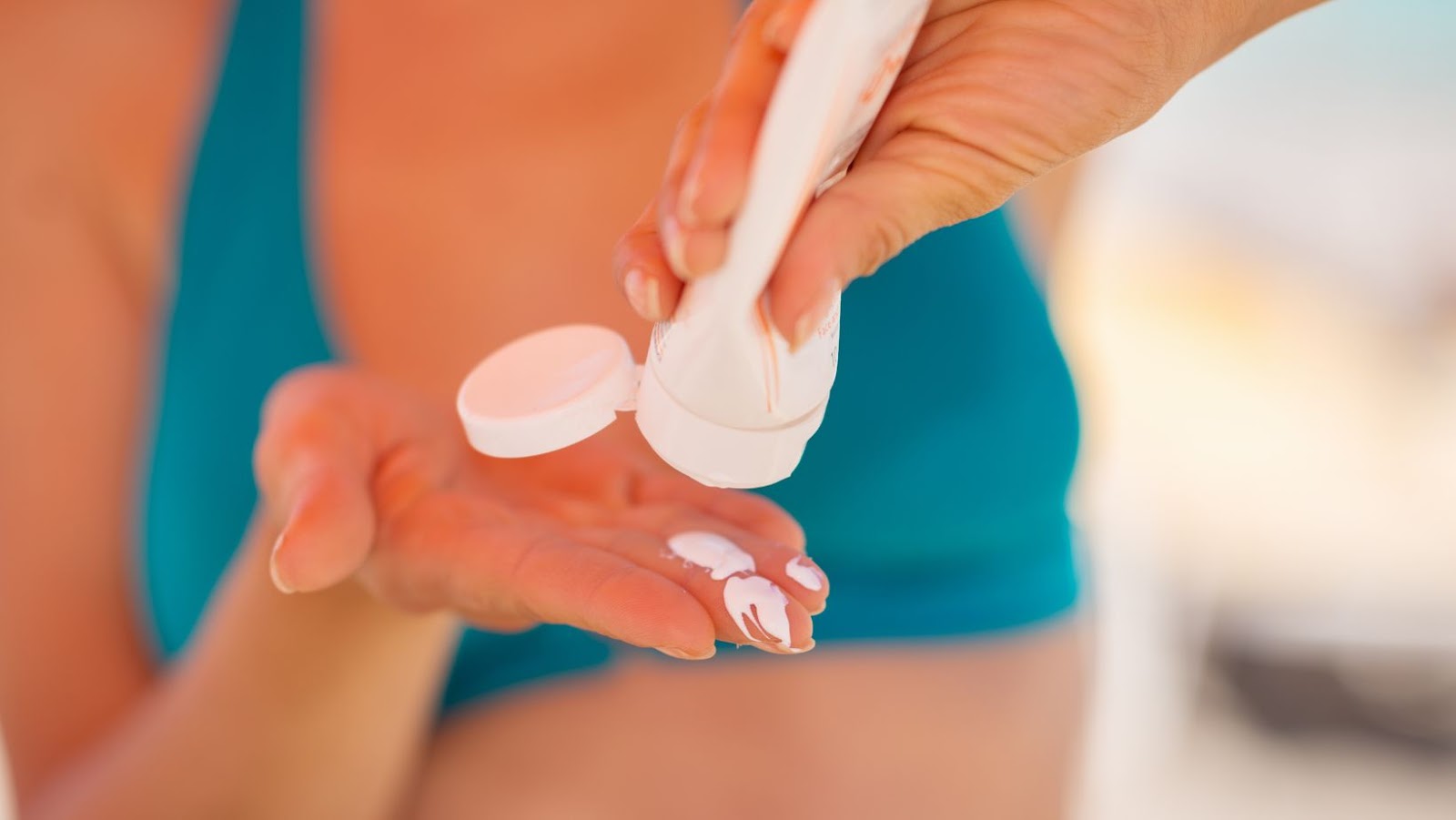
How To Apply Sunscreen And Moisturizer For Optimal Results
Proper skincare routine is essential for healthy skin. Here’s a guide on how to apply sunscreen and moisturizer for optimal results.
| Step | Action |
| 1 | Start with a clean face. Wash your face with a gentle cleanser and pat it dry with a soft towel. |
| 2 | Apply moisturizer. Take a small amount of moisturizer and apply it to your face and neck, gently massaging it in circles. Wait for a few minutes to let it dry completely. |
| 3 | Apply sunscreen. Take enough sunscreen and apply it on your face, neck, and any other exposed areas. Massage it in circular motions until it’s fully absorbed. |
Pro tip: Use a moisturizer with SPF protection to save time and keep your skin well-hydrated and protected at the same time. Always reapply sunscreen every 2 hours to maintain its effectiveness.
Understanding the Differences Between Sunscreen and Moisturizer
Sunscreen and moisturizer are two important skincare products that both help protect and nourish our skin. But do you know the differences between them and how to apply them correctly and effectively?
A fundamental understanding of how these products work and interact together will help you apply them properly and ensure you get the best results. Let’s dive deeper into the differences between sunscreen and moisturizer.
Function of a Sunscreen
The primary function of a sunscreen is to protect the skin from the harmful effects of the sun’s UV radiation, preventing sunburns, premature aging, and skin cancer. Unlike moisturizers, sunscreens contain active ingredients that form a protective barrier on the skin’s surface, absorbing or reflecting UV rays from the sun. When applying sunscreen, it’s essential to use enough to achieve the desired protection level, reapply it frequently, and choose a broad-spectrum product that protects against both UVA and UVB rays.
Moisturizers, on the other hand, hydrate and nourish the skin, improving its texture and appearance, but they don’t provide significant protection against the sun’s rays. To achieve optimal results, it’s recommended to use both a moisturizer and a sunscreen in your daily skincare routine. Apply the moisturizer first, allowing it to absorb into the skin before applying the sunscreen.
Function of a Moisturizer
The function of a moisturizer is to hydrate and protect the skin by locking in moisture and creating a barrier against environmental stressors. Moisturizers contain ingredients such as emollients, occlusives, and humectants, which work together to keep the skin hydrated and help restore its natural protective barrier.
However, it’s important to note the differences between sunscreen and moisturizer. While moisturizers hydrate and protect the skin, they do not provide sufficient protection from harmful UV rays. Sunscreen contains specific ingredients that block or absorb damaging UV rays, preventing skin damage and reducing the risk of skin cancer. To ensure maximum protection for your skin, apply a broad-spectrum sunscreen with an SPF of at least 30 after applying your moisturizer, particularly if you’re spending time outdoors.
Pro tip: Opt for a moisturizer with a lightweight, non-greasy formula to prevent clogged pores and breakouts.
Can Sunscreen be Used as a Moisturizer?
Sunscreen and moisturizer are two distinct skincare products with different purposes. Although they contain similar ingredients, it is not recommended to use sunscreen as a moisturizer. Sunscreen is designed to protect your skin from the harmful UV rays of the sun, and its formulation is made to provide a barrier on your skin’s surface, preventing sun damage. On the other hand, moisturizer is used to hydrate and nourish your skin, acting as a protective barrier on the surface while also penetrating deep below to hydrate and repair the skin.
While some modern sunscreens may contain ingredients such as hyaluronic acid and ceramides that help hydrate the skin, they do not have the ability to fully meet the hydration needs of your skin. Therefore, it is essential to use a separate moisturizer after applying the sunscreen. For optimal results, apply sunscreen first and then a moisturizer at least 15-20 minutes after sunscreen application.

Applying Sunscreen and Moisturizer in the Correct Order
The correct order to apply sunscreen and moisturizer can be one of the most important steps when it comes to taking care of your skin. Whether you are looking to reduce the effects of aging or prevent sunburns, understanding the order of application can make all the difference.
Let’s explore how you should be applying your sunscreen and moisturizer for optimal results.
Does Sunscreen go Before or After Moisturizer?
Sunscreen should always be applied after moisturizer to ensure optimal protection from the sun’s harmful rays and to keep your skin moisturized.
Here’s the correct order to apply sunscreen and moisturizer:
| Step | Instructions |
| Step 1 | Apply your regular moisturizer to clean and dry skin. |
| Step 2 | Allow your skin to absorb the moisturizer for a few minutes. |
| Step 3 | Apply sunscreen generously to your face and neck, making sure to cover all exposed areas. |
For best results, choose a moisturizer and sunscreen with SPF 30 or higher to provide adequate protection. Don’t forget to reapply sunscreen every two hours when outside or after swimming or sweating.
Pro tip: Consider using a moisturizer with built-in SPF for added convenience and protection.
The Importance of Following the Correct Order
Following the correct order of applying sunscreen and moisturizer is crucial in ensuring optimal results for your skin. Here’s why:
- Sunscreen acts as a protective barrier against the sun’s harmful UV rays, while moisturizer helps to hydrate and nourish the skin.
- If you apply moisturizer before sunscreen, you risk diluting the effectiveness of the sunscreen and reducing its ability to protect your skin.
- Additionally, applying sunscreen before moisturizer can make it harder for the moisturizer to penetrate your skin properly, leaving it feeling greasy or oily.
Therefore, it’s important to follow the correct order of applying sunscreen first and then moisturizer for maximum protection and hydration for your skin.
Can You Skip Moisturizer if You are Using a Sunscreen?
While sunscreens are an indispensable part of our skincare routine, skipping moisturizer can negatively impact the skin’s health. Moisturizers hydrate and nourish the skin, keeping it supple and smooth. On the other hand, sunscreens protect the skin from harmful UV rays that cause skin damage and aging. However, moisturizers enhance the effectiveness of sunscreens, reducing the risk of sun damage.
The right way to apply sunscreen and moisturizer is to use a moisturizer first and allow it to get absorbed before applying sunscreen. This ensures that the skin gets adequately nourished before applying sunscreen, which can be harsh on the skin. Applying sunscreen over a moisturizer can also help prevent clogged pores and acne breakouts.
So, to answer the question, it’s never a good idea to skip moisturizer, even if you use sunscreen regularly. Instead, apply a moisturizer first, give it some time to sink in, and then apply sunscreen over it for optimal skin health.

Tips for Applying Sunscreen and Moisturizer Correctly
Knowing the correct order of applying sunscreen and moisturizer is an essential part of achieving optimal results with these products. With the wrong order, your skin may not reap the full benefits of the products, and you may be left with insufficient protection from the sun’s harmful rays.
Here are some tips to ensure correct application and reap the most out of sunscreen and moisturizer:
| Product | Order |
| Sunscreen | First |
| Moisturizer | Second |
Apply Sunscreen or Moisturizer to Clean, Dry Skin
The key to optimal results when applying sunscreen or moisturizer is to make sure your skin is clean and dry before application. This ensures that the product is absorbed properly and that it provides maximum protection.
Here are some tips for applying sunscreen and moisturizer correctly:
|
|
|
|
|
Pro tip: Always wait a few minutes after application before going outside to let the product absorb into your skin properly. Reapply sunscreen every two hours when out in the sun.
Use the Appropriate Amount of Product
Using the appropriate amount of product is crucial for optimal results when applying sunscreen and moisturizer.
Follow these tips for correct application:
| Sunscreen | Moisturizer |
| Use a shot glass-sized amount of sunscreen for your whole body and a nickel-sized amount for your face. Apply it generously and evenly, at least 15 minutes before sun exposure, and reapply every two hours or after swimming or sweating. | Use a dime-sized amount of moisturizer on your face and neck. Apply it in upward circular motions with your fingers, avoiding the eye area, and let it absorb into your skin fully before applying makeup, sunscreen, or going to bed. |
Using too little product can decrease its effectiveness, while using too much can cause skin irritation and clog pores, leading to breakouts. Always read and follow the product instructions, especially when using new or higher SPF products.
Pro tip – Applying sunscreen and moisturizer at the same time can help you save time and layer up without clogging pores.
Reapply Throughout the Day
To ensure maximum protection from the sun’s harmful rays, it is essential to apply sunscreen and moisturizer correctly by reapplying it throughout the day. Here are some tips to follow:
| Step | Instructions |
| 1 | Apply sunscreen and moisturizer on dry skin, 15-30 minutes before stepping into the sun. |
| 2 | Use the right amount of sunscreen and moisturizer, as recommended by the manufacturer. For sunscreen, apply at least a nickel-sized amount for your face and a shot glass-sized amount for your body. |
| 3 | Reapply sunscreen every 2 hours, especially if you are sweating or swimming. |
| 4 | Moisturizer should be reapplied every 4-6 hours, with an extra application at night before bedtime. |
Follow these guidelines to protect your skin from sun damage and keep it moisturized throughout the day.
Choosing the Right Sunscreen and Moisturizer for Your Skin Type
Choosing the right sunscreen and moisturizer combination can be tricky.
Sunscreen is an essential part of any skincare routine to protect your skin from damaging sun rays. Moisturizer is also important for keeping your skin hydrated and preventing it from becoming dry and irritated.
In this article, we’ll look at the different types of sunscreen and moisturizer that are available, and how to choose the right one for your individual skin type.
Understanding Your Skin Type
Understanding your skin type is crucial for choosing the right sunscreen and moisturizer, and for applying them in a way that yields optimal results.
There are 5 basic skin types:
| Type | Description |
| Normal skin | Not too oily or dry, with small pores and an even skin tone. |
| Oily skin | Shiny and greasy-looking, with large pores and a tendency towards acne and blackheads. |
| Dry skin | Flaky, tight, and itchy, with visible fine lines and wrinkles. |
| Combination skin | Oily in the T-zone (forehead, nose, and chin) and dry or normal on the cheeks. |
| Sensitive skin | Easily irritated by skin care products, weather changes, or certain ingredients. |
To choose the right sunscreen and moisturizer for your skin type, look for the following:
- Normal skin – a lightweight, non-greasy formula that offers broad-spectrum protection.
- Oily skin – an oil-free, mattifying formula that helps control shine and prevent breakouts.
- Dry skin – a nourishing, hydrating formula that contains ingredients like hyaluronic acid or glycerin.
- Combination skin – a balancing formula that addresses both oily and dry areas.
- Sensitive skin – a fragrance-free, hypoallergenic formula that contains soothing ingredients like aloe vera or chamomile.
For optimal results, apply sunscreen and moisturizer daily, 15-20 minutes before sun exposure. Reapply sunscreen every 2 hours and after swimming or sweating. Apply moisturizer according to your skin needs and type, focusing on dry areas and avoiding the T-zone for oily skin.
Choosing the Right SPF for Your Skin Type
Choosing the right SPF for your skin type is crucial to protect your skin from harmful UV rays and maintain a healthy and youthful complexion. Here are some guidelines to follow for each skin type:
| Skin Type | SPF Recommendation |
| Fair skin | SPF 30 or higher for maximum protection. |
| Medium skin | SPF 15 to 30 is suitable for moderate protection. |
| Olive skin | Choose SPF 15 for mild protection. |
| Dark skin | SPF 15 offers sufficient protection for dark skin. |
Additionally, it’s important to choose a sunscreen and moisturizer that is compatible with your skin type. If you have oily skin, use an oil-free and non-greasy formula; for dry skin, choose a moisturizing formula with added hydration. Apply the products generously and evenly to all exposed skin and reapply every two hours or after swimming or sweating. Pro Tip: Don’t forget to apply sunscreen and moisturizer to your neck, ears, and hands for ultimate sun protection.
Choosing a Moisturizer Based on Your Skin Concerns
Choosing a moisturizer based on your skin concerns is important to ensure that you are getting the right benefits for your skin type and specific concerns.
- Dry Skin: Choose a moisturizer that is rich and thick, like a cream, rather than a lighter lotion. Look for moisturizers that contain ingredients such as hyaluronic acid and glycerin, which will help to hydrate and lock in moisture in your skin.
- Oily Skin: Opt for a lightweight moisturizer that is non-comedogenic, meaning it won’t clog your pores. Ingredients like salicylic acid and benzoyl peroxide are also helpful in regulating oil production and treating and preventing acne.
- Aging Skin: Look for a moisturizer that contains ingredients such as retinoids or peptides, which can help to boost collagen production and reduce the appearance of fine lines and wrinkles.
When choosing a sunscreen, opt for a broad-spectrum sunscreen with an SPF of at least 30. Apply sunscreen generously to all exposed skin, and reapply every 2 hours or more often if swimming or sweating.
Pro Tip: Combine your SPF with your moisturizer to save time and money. Look for a moisturizer that contains SPF for an easy, all-in-one solution.






